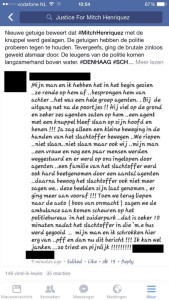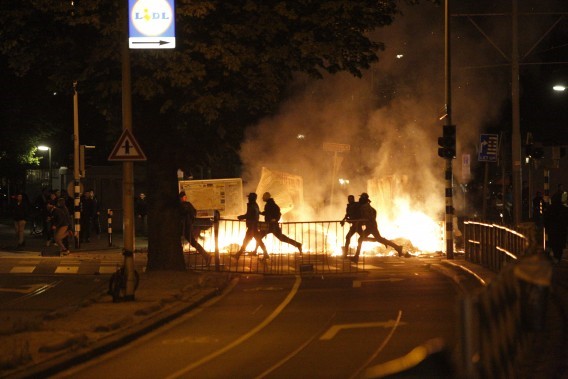He had come to the Netherlands for a family visit, the Aruban Mitch Henriquez. On Saturday the 27th of June he enjoyed a UB40 concert at Night at the Park in The Hague. Ostensibly, he had shouted that he had a “gun” in his pocket, which according to some bystanders was a joke: in a Caribbean context “gun” can refer to an impressive penis. The police responded and attempted to bring him into custody and later declared that he had resisted his arrest. Preliminary results from the autopsy now indicate that Henriquez died of asphyxiation after being held in a chokehold and being crushed by five white officers who sat on his body. The national department of criminal investigation has now ruled out that he had a gun. Nor had he used drugs or too much alcohol, according to the toxicology report.
Just like many of the encounters of African Americans with the US police, the attempted arrest was captured on video with a smartphone and directly uploaded on the web. At first, the Public Prosecution Service, as it is called in the Netherlands, had stated in a press release that Henriquez had become unwell on his way to the police station. But the video left no room for doubt: Henriquez was already unconscious when he had five officers sitting on his body. Instead of following emergency protocol prescribing immediate reanimation, he was dragged into a police vehicle. Online, people immediately started to invoke images of Freddy Gray, who was forced into a police van by the Baltimore police while having a broken neck. Gray died a week later; Henriquez died the next day. The Prosecutors caved under the pressure of grassroots media; they had to clean up their act and admit that Henriquez was already “dying in the dust” – to sing with UB40. Somehow I can’t stop thinking that this song (Food for Thought) was the last one he heard.
Interestingly, this single event (which is not to say that we are facing an isolated or private incident instead of a public issue) appears to have a better chance of reforming our criminal justice system than a 6-year ethnographic project which I recently concluded by defending my dissertation, titled A Public Anthropology of Policing: Law Enforcement and Migrants in the Netherlands. In the dissertation it is concluded that police discrimination in the Netherlands is on the rise because
‘with the advent of “psy-frames”, police work and police officers are increasingly psychologized and boundaries between the private and the public are blurred. This does not only lead to the “inclusion” of the whole personality and personal judgment of police officers at work, but also to a police force that no longer hesitates to work itself into the private lives of the public’ (back cover).
Echoing the responses to Didier Fassin’s famous study on anticrime squads in Paris, the results of the study went viral in the media. Every national newspaper and the majority of TV and radio stations reported on it, leading to front-page articles and national broadcasts. The media had started to institute a positive public opinion with respect to my study, but the national police stepped up its vigil and discredited the project. Despite the fact that our national Chief of Police had posted a blog just a few months earlier in which he stated that ethnic exclusion was “intoxicating” his organization, he now wrote in a press release that he rejected my conclusion that police discrimination is a structural problem. At first, some of the migrant-hostile police projects that I described in my dissertation (such as PsyCops) were even claimed not to exist, according to some journalists. When these journalists started to push by means of our Freedom of Information Act (Wet Openbaarheid Bestuur), a step-by-step confession occurred. Another project which I had prepared with a local police department in my hometown – and which was about to take place after the summer – was suddenly cancelled: a pilot project that included stop forms as a check on police discretion/discrimination. In fact, in another press release it was stated that there never was an agreement to start the project in the first place.
In line with what may be expected from a public anthropology, I disseminated my findings as well as I possibly could, enabling different publics to be informed, make up their minds and take actions accordingly. Although the study was subject of discussion in various city councils and in parliament, I don’t think it will have as much effect as the current events that unfold in The Hague and on the Internet as I write. I say this without regret: I honestly don’t care if it is research and advocacy or activism and protest that lead to a more democratic and neutral police. My pragmatism tells me “whatever works”. But I do believe that there are interesting combinations to be made.
This brings me to the power of “hashtag activism” and grassroots social movements and the importance of studying them. In a recent article in American Ethnologist Yarimar Bonilla and Jonathan Rosa wrote the following:
‘Through a theorization of hashtag usage, we discuss how and why social media platforms have become powerful sites for documenting and challenging episodes of police brutality and the misrepresentation of racialized bodies in mainstream media. We show how engaging in “hashtag activism” can forge a shared political temporality, and, additionally, we examine how social media platforms can provide strategic outlets for contesting and reimagining the materiality of racialized bodies’ (2015: 4).
This quote is multidimensional and we first need to pull apart the separate dimensions before we can show the strength of them coming together in a collaboration of research/advocacy and activism/protest.
First, there is the virtue of social media platforms as sites where episodes of disproportional or illegal police violence can be documented in an uncensored language – and when I say language, I have a multimodality in mind that includes text, video and images. If it wasn’t for the video, we would not now have millions of witnesses of a tragic event. If it wasn’t for the video, we would now in all likelihood still be under the impression that Henriquez lost conscious during transport.
Additionally, eyewitness accounts can become publically available when a bystander decides to turn to a social media platform with his/her story. Evidently, such accounts must be filtered and this is, basically, criminal justice work. But when the police itself are scrutinized in a criminal investigation, the public deserves to be informed directly and social media are a good way to go. Frontline organizations such as the police ought to be subjected to critical review at all times, particularly so when they seem to be involved in illegal activities.
Second, as Brassard and Partis write in an article in Anthropology News, the digital landscape ‘activates imaginative ways of relating lightly packaged information (rather than tightly narrated facts) to and with diffuse individuals and collectivities: social media connectedness and exchange are part of a narrative-building apparatus that rebuffs static tropes and hegemonic imagery’ (2015: 8). If we look at the protests in The Hague that are taking place in the aftermath of Henriquez’s death, we can clearly see the discrepancy between mainstream media discourses and grassroots discourses. Basically all we see in national newspapers is images that portray a warzone. These pictures as well as quotes taken from our Prime Minister who talked about the protesters as “retards” (achterlijke gladiolen) who destroy the private property of innocent citizens, or The Hague’s mayor who talked about the riots as a result of extreme temperatures and the Ramadan (utterances that are shot through with condescension), seem to work as a legitimation of the arrest of more than 250 protesters (based on local zoning ordinances). The Public Prosecutor has already announced that many of these cases can be processed through fast track courts (snelrecht), which in all likelihood will mean that they will be stripped of their political and societal context and taken as individual cases.
In contrast to this one-dimensional portrayal we find all kinds of perspectives on grassroots media sites, where one can follow several simultaneous live streams (protestors tweeting, police and politicians talking, journalists reporting, the victim’s family mourning, etc.). A nuanced whole is constructed on the basis of a plurality of voices and lightly packaged information instead of tightly narrated facts. Surely, this includes critical accounts of protester actions but also accounts of neighbourhood collectives in dialogue with local police or youngsters sharing autobiographical accounts of police violence in a highly sophisticated way. On Joop.nl for instance, a well-known left-wing media platform in the Netherlands, Mitchell Esajas (chair of the New Urban Collective) made an interesting reference to Martin Luther King Jr.: A riot is the language of the unheard. This made me think of the work of the founding father of Critical Criminology, Richard Quinney, who wrote in his book The Social Reality of Crime about the politicality of crime:
‘by which he means, first, that the actions of many criminally defined persons are actually political behaviors and, second, that the actions taken in the labelling of behavior as criminal are political actions’ (A. Javier Treviño, 2002: xiii, in his introduction to the Transaction Edition).
In other words, the riots and destruction in The Hague that occurred after Henriquez’s death ought not only to be understood as criminal acts but also as political acts that are a direct challenge to the status quo in minority neighborhoods, where police have brutality threated especially migrant youngsters for a long time (see here, and here, and here, and…). In these protests we see the emergence of what Bonilla and Rosa call a “political temporality”; a political moment that attracts a superdiverse group of people who all feel the need to challenge the criminalization of migrant youngsters and who understand this process as a political process.
Now, if we take these three dimensions together (uncensored critique of police violence, lightly packaged info challenging dominant discourses, and a plurality of voices that stress the politicality of crime [fighting]), we begin to see that online manifestations of dissatisfaction with police offer valuable materials for anthropological research. Already for a long time anthropologists have been concerned with the public value of their work (see Eriksen and Mutsaers for overviews) and with the felt need to give voice to those who otherwise remain silent (see for example Hymes or Fabian).
I believe that we, as anthropologist, have much to learn from these online and offline protests against police violence. Reversely, we can help those who raise their voice to turn their initiative into a true effort to democratize our police organizations. Research, advocacy, protest and activism can all be fruitfully combined as long as relationships with police are maintained.
Paul Mutsaers works as a Postdoctoral Research Fellow at the Tilburg School of Humanities. He is the editor of Anthropoliteia’s Book Reviews.



Pingback: Spannend boek van een spannende man | blog